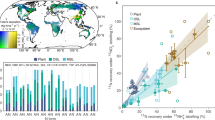Abstract
Nitrogen is lost as dissolved organic compounds in stream waters from unpolluted South American forests, but it is lost mainly as inorganic nitrate in streams flowing from North American forests that suffer nitrogen deposition from the atmosphere1. From this it has been inferred that the standard thinking about how nature deals with nitrogen in soils and waters2 needs to be re-evaluated and that the conventional wisdom of how nitrogen is absorbed and released by plants3 must be wrong. We disagree, however, on the grounds that there are other, more likely interpretations of the new results1.
Similar content being viewed by others
Main
How nature deals with nitrogen depends greatly on temperature. Rye-grass plants supplied with equal concentrations of ammonium and nitrate take up an increasing proportion of ammonium as the temperature becomes cooler4. Plants are equipped with transport mechanisms for a variety of nitrogen-containing organic solutes5 and they can absorb small organic molecules such as amino acids in northern temperate forests with cool temperatures6.
This flexibility might have evolved because the microbes responsible for releasing soil organic nitrogen as ammonium, and for converting the ammonium to nitrate, become less active as the temperature falls: the conversion to nitrate is inhibited7,8 at 3–5 °C. This implies that the cooler the average temperature is, the more important it becomes for plants to be able to manage without nitrate and to utilize nitrogen compounds that have not been fully processed by the soil microbes.
The mean annual temperatures at the sites of the South American forest studies1 were quite low (4–11 °C) so plants there might well have absorbed small nitrogen-containing organic molecules. But the dissolved organic nitrogen found in forest streams does not prove this: 'dissolved' was defined1 as passing through a filter of pore size smaller than 1 µm and would therefore have included molecules up to 1,000 times larger than those taken up by plants, together with colloidal organic matter and bacteria9.
The 'dissolved' organic nitrogen is probably in those streams for the simple reason that it is not needed. A forest ecosystem with no input of nitrogen would evolve to recycle usable nitrogen, inorganic or organic, and to minimize its loss in streams. But very large organic molecules and colloidal organic matter are not usable by plants. The significance of the 'dissolved' organic nitrogen in those streams is not that these are the forms of nitrogen that the forest uses, but that they are the forms that it does not recycle because it cannot use them. These results do not call for a re-evaluation of our thinking about how nature deals with nitrogen in soils and waters because they are what we would expect from our current understanding of the situation.
References
Perakis, S. S. & Hedin, L. O. Nature 415, 416–419 (2002).
van Breemen, N. Nature 415, 381–382 (2002).
Pearce, F. New Scientist 11 (26 January 2002).
Clarkson, D. T. & Warner, A. J. Plant Physiol. 64, 557–561 (1979).
Williams, L. E. & Miller, A. J. Annu. Rev. Plant Physiol. Plant Mol. Biol. 52, 659–688 (2001).
Persson, J. & Näsholm, T. Ecol. Lett. 4, 434–438 (2001).
Anderson, O. E. Soil Sci. Soc. Am. Proc. 24, 286–289 (1960).
Tyler, K. B. et al. Soil Sci. 87, 123–129 (1959).
Herbert, B. E. & Bertsch P. M. in Carbon Forms and Functions in Forest Soils (eds Kelly, J. A. & McFee, W. W.) 63–88 (Soil Sci. Soc. Am., Madison, Wisconsin, 1995).
Author information
Authors and Affiliations
Corresponding author
Rights and permissions
About this article
Cite this article
Addiscott, T., Brookes, P. What governs nitrogen loss from forest soils?. Nature 418, 604 (2002). https://doi.org/10.1038/418604a
Issue Date:
DOI: https://doi.org/10.1038/418604a
Comments
By submitting a comment you agree to abide by our Terms and Community Guidelines. If you find something abusive or that does not comply with our terms or guidelines please flag it as inappropriate.



